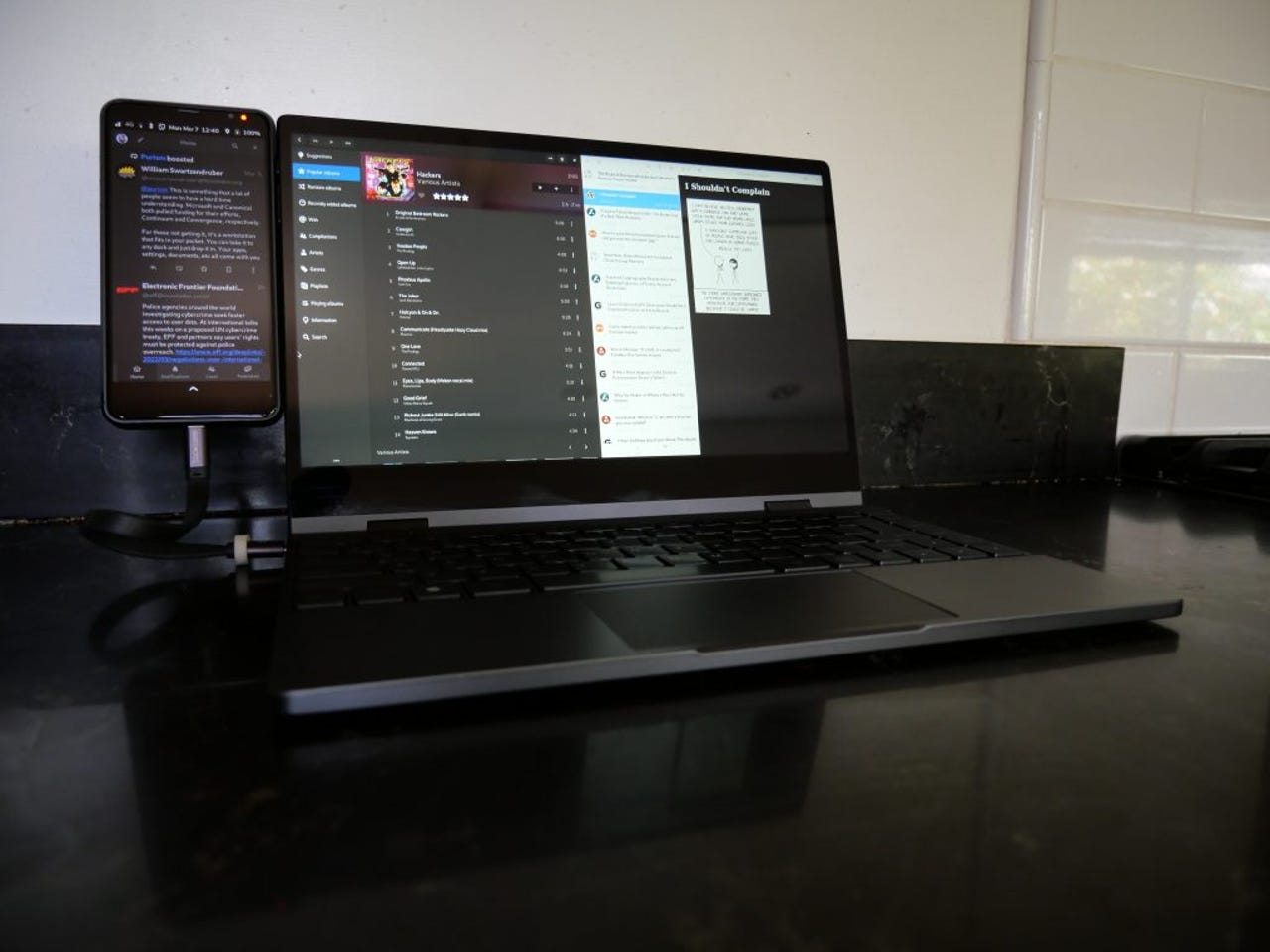This 'lapdock' kit turns an open-source smartphone into a laptop


Librem 5 Docked to a Nexdock 360 running Tootle, Lollypop, and Feeds.
Purism, the makers of the Linux Librem 5 smartphone and Librem 14 laptop, have released the Lapdock Kit -- a docking station-based laptop with a touchscreen, keyboard, trackpad, lots of ports, but no processor, memory, or storage.
There was a time, in the early 2010s, when some experts believed converged devices combining smartphones and laptops would be the future of computing.
One of its main proponents, Mark Shuttleworth, CEO of Canonical, tried to bring this vision to reality with the Ubuntu Edge concept smartphone and Ubuntu Touch, a smartphone version of Ubuntu desktop for running desktop and smartphone apps on one platform.
Also: The best Linux distros for beginners
Today, the convergence vision lives on in Purism's Librem 5 smartphone, which in its original 2013 embodiment ran on Ubuntu Touch.
The Librem 5 and Librem 14 laptop run on PureOS 10. The Libra 5's price tag of $1,299 is steep given the specs, but it could be seen as better value when its combined with the new $399 Lapdock Kit.
The Lapdock Kit's main feature is the NexDock 360, which is basically a laptop without a CPU, RAM or storage. It sports a 13.3-inch 1920×1080 resolution touchscreen, a backlit keyboard with trackpad, several essential ports (listed below), four speakers, and a 44 Wh battery. The kit also includes a magnetic mount and a short USB-C cable.
The value from combining the smartphone with a Lapdock hinges on Purism's work in making its Debian-based PureOS a truly convergent OS. Purism promotes this effort as "real convergence".
Kyle Rankin, president of Purism, argues in a blog post that PureOS is truly convergent compared to other operating systems, such as Android and iOS. Google, for example, has enabled Android apps to run on Chromebooks; Microsoft is gradually improving the Android Subsystem for Windows for running Android apps on Windows 11; Apple's M1 and M2 macOS Macs can run iOS apps, but without touch on macOS; and Samsung has been working on Galaxy with its DeX platform.
By contrast, Rankin says the Librem 5 and Librem 14 run the same version of PureOS and that apps are made for the laptop first, but also run on mobile.
"This means that they are not running applications that have been ported to a mobile platform, instead [it's] the same desktop applications as our full-sized computers, just on a smaller screen. When only using the Librem 5 in its mobile form factor, it's easy to overlook that this is happening, as adaptive applications morph to fit the smaller screen," he says in the blog post.
"If you come from an Android or iOS background, you may only notice that the apps have odd names and are different from what you are used to. Even if you come from a Linux background and recognize these apps you may overlook the power of convergence, because there are other mobile platforms, including FDroid on Android devices, that have ported popular Linux desktop apps to mobile-only versions. It's only when you dock the Librem 5 that you really experience the power of convergence."
Also: The best Linux laptops you can buy
Rankin says he can set up the phone and lapdock screens side by side using the magnetic mount, so that he can use both touchscreens as well as the keyboard and mouse. Rankin contends that having the screens side by side makes it easy to view applications on both screens, with two apps tiled on the lapdock screen.
The Lapdock Kit also fills an app gap on the Librem 5.
"Traditional Linux applications like the full LibreOffice suite, GIMP, Wireshark, Gqrx and many others run well on the Librem 5 with the addition of the Lapdock Kit's extra screen real estate," says Rankin.
He also argues that those with a Lapdock Kit and a Librem 5 "may no longer feel the need to pack a laptop with you on trips." That argument would could make sense for those otherwise carrying a 2.7lb Dell XPS 13 Plus, but at 2lb 10 oz, the NexDock 360 wouldn't appear to save that much on weight or space.
NexDock 360 specs:
Display: 13.3 inch IPS 1920×1080
Battery: 44 Wh
Input ports: 1 x USB-C 3.1 with DisplayPort, 1 x Mini HDMI-in (1.4a) Port
Output ports: 1 x USB-C PD Charging Port, 1 x USB-C 3.0 Data Port, 1 x 3.5mm audio jack, 1 x Micro SDXC card reader
Audio: 4 x 1W speakers
Keyboard: Edge to edge full-sized backlit keyboard with multi touch trackpad
Dimensions: 12.1″ x 8.2″ x 0.6″ (30.7 cm x 20.9 cm x 1.5 cm)
Weight: 2 lb 10 oz (1190 g)